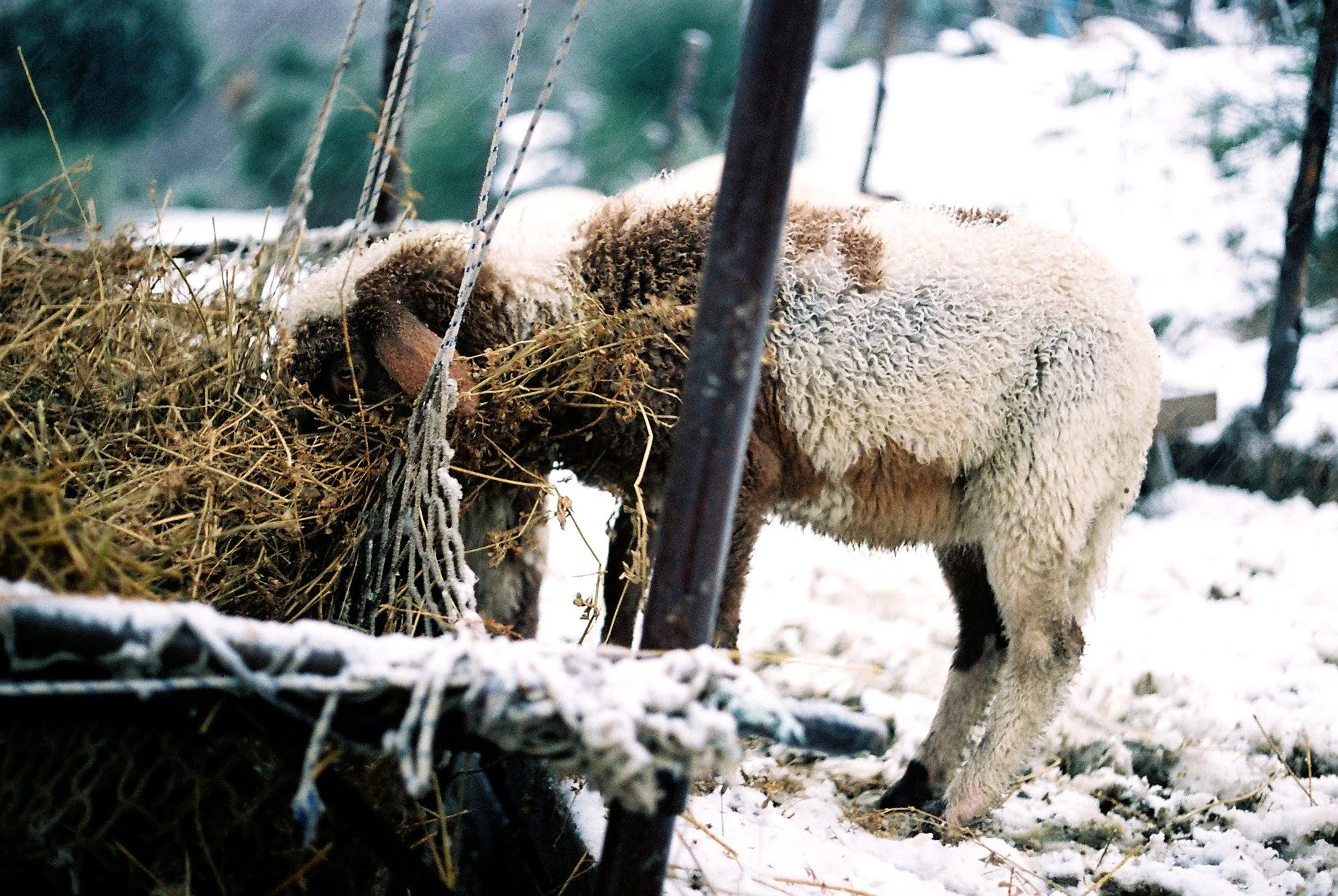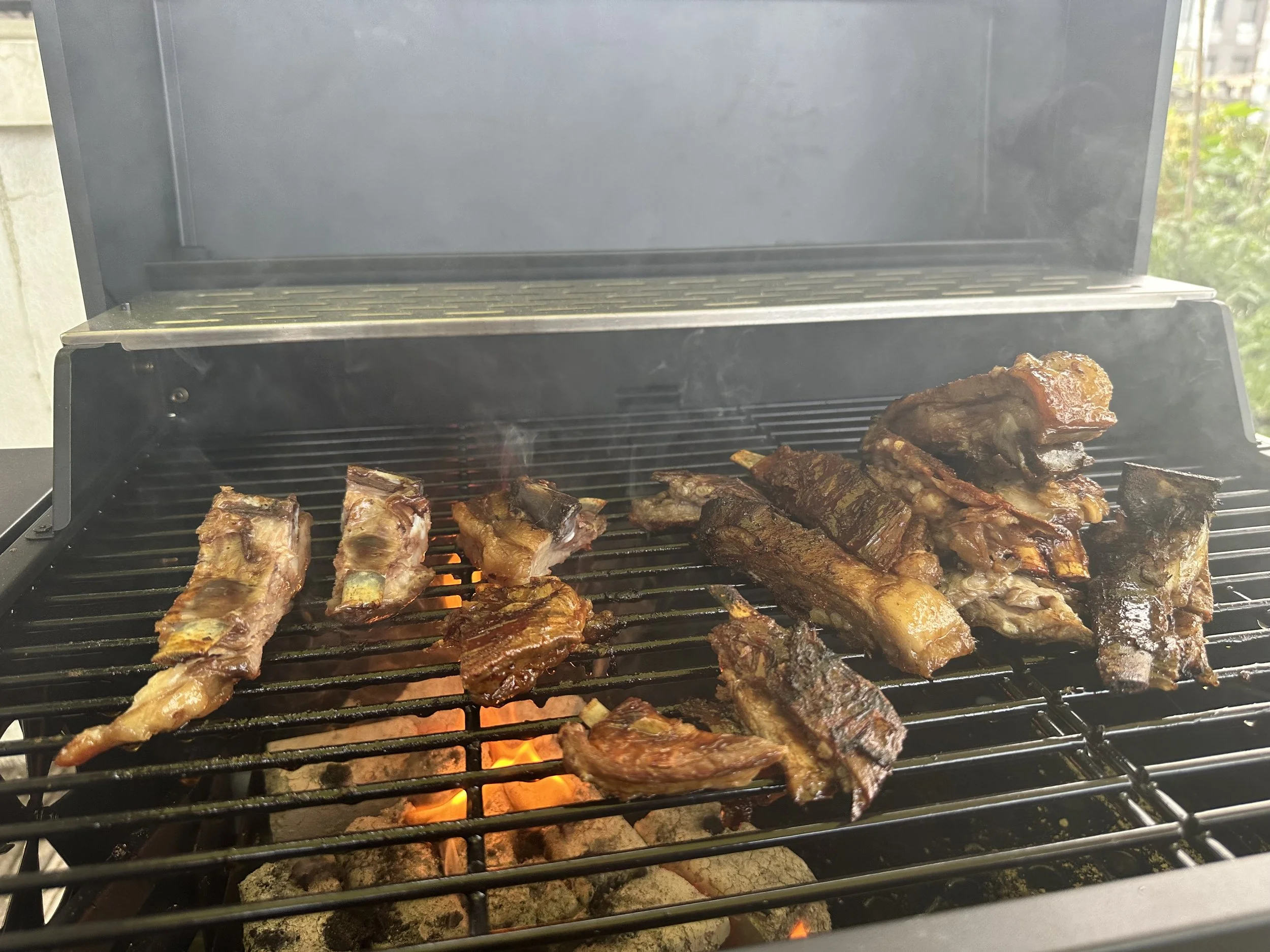Ròu | 肉 | Meat
A Quick History of Meat in Northern China
The first humans to put shovel to soil may well have been the Northern Chinese. Over 10,000 years ago a curious disruptor dropped a few seeds into the mud of the Yellow River Valley and was later rewarded with rows of seeded millet grass. The story of China begins here. Without millet, there would arguably be no Middle Kingdom at all. For thousands of years, millet supported communities, cities and whole dynasties in the North. Chinese cuisine was born in the silt of the this valley, but not much could flourish. Rice, fruit and most vegetables were unable to survive the vicious winds, the brutal winters and unpredictable droughts. It was a hostile climate for most of the year, suitable for only the hardiest of creatures: humans, cows, yaks and sheep.
Northerners reared livestock out of necessity but quickly grew to love their diet. The Southern Chinese, however, saw these people as barbarians: meat-loving brutes with no sense of refined elegance; the kind of people that turned up to the dinner table with a dagger tucked into their belt, ready to carve up ribs of lamb. The Southerners constantly made fun of the North for their simplistic diet of meat and millet and their love of spoiled milk products like yogurt and cheese. The warrior rulers of the North, in particular the Mongols of the Yuan Dynasty, were feared but rarely respected. They were outsiders. They didn’t understand the beauty of Chinese food, the diversity of flavours, the need to balance sweet with bitter, sour, pungent and salty. What skill was there in putting meat to fire?
At its simplest, China has been historically divided into two regional diets: the North: a land of wheat, meat and dairy, and the South: a land of rice, fish and fruit. Not much has changed today. The North still make fun of the South for eating anything with four legs, except tables and chairs, and the South sees Northern food as boring, plain and unappetising. The dishes I eat in Beijing today are often remarkably similar to a dinner of five-hundred years ago.
The Diversity of China
Historically, the consumption of meat in Chinese cuisine was extremely low. Before 1949, most Chinese farmers received 89% of their calories from grains versus around 1% of calories from meat. But in the North they had little choice but to rely on meat and become experts in butchery, cooking, preserving and eating meat. All regional cuisines in China were based on the geography around them. The North did not have lichees and oranges from tropical Guangdong, they did not have crabs and crayfish from the lakes of Zhejiang or Hubei, and they did not have the hundreds of wild plants and mushrooms from Yunnan. Instead, they had grassland, thousands of miles of prairie stretching across most of Inner Mongolia, Gansu, Qinghai and Xinjiang. The UK would fit four times into the vast, empty grasslands of Northern China. The nomadic tribes worked with the rolling hills, rearing millions of sheep, relying on lamb and mutton for the majority of their calories. As the Mongols moved into the capital city and became rulers, their eating habits remained. They build pens for live sheep in the palace grounds of Beijing, and reportedly butchered about 48 sheep a day just for the emperor and his staff. This obsession with lamb did not catch on in Southern provinces, and even today, lamb is rare in the South of China.
The wealthier classes of China, however, preferred a wider diversity of meat. As far back as the Tang Dynasty, three-hundred years before the Mongol-ruled Yuan Dynasty, they were experimenting with meat. Lamb and mutton of course, but also chicken, pheasant, partridge, goose, duck and quails; horse, wild rabbit, goat, boar, deer, dog and frog, and the more extravagant elephant, python, sea otter, bear, peacock and even newborn baby rats stuffed with honey and served live. The rich were happy to spend extraordinary sums of money on flashy meats for their table. The land of China had an unrivalled diversity of produce and a pastime of the wealthy was culinary exploration. When Marco Polo arrived in China in the 12th century, he travelled extensively and marvelled at the abundance of forest, wild animals and game. But other travellers to China were not so complimentary. Long lists of strange animal meats were often used to prove how uncouth the Chinese were compared to refined English culture. Eating chicken hearts and rabbit’s head couldn’t have been further from the meat-and-two-veg of English cooking. These commentators failed to understand the innovation and sophistication of Chinese cuisine; that a Chinese chef could take any ingredient - the foot of a chicken, the liver of a pig, even the tongue of a duck - and turn it into a delicious morsel. The Chinese were not adventurous eaters, rather, they trusted a chef’s alchemic ability to turn water into a rich soup, bones into treats, offal into delicacy. Any basic culture could roast a hunk of beef in an oven and make it taste good, but only a skilled master can turn humble cuts into desirable luxuries. The British traders were far too squeamish and culinarily uncreative to understand the depth of Chinese food.
Over the decades, many meats became less popular in China, either because of trends, rarity or regionality. In modern China, there is virtually no forest left, less wilderness and smaller grasslands than even a hundred years ago. In all my years of traveling in China, there are few places when you are truly alone. Humans are everywhere: cities have encroached into the jungles, factories were built across rural plateaus, Mao’s industrialisation forced mass deforestation, and over-hunting left wild animals endangered. Although the Chinese diet has a much more diverse diet than in the West, today it relies on only a handful of animal proteins.
Lamb: The Muslim Influence
As early as the Tang Dynasty (618-906CE) muslim populations were in China. They influenced the emperor’s city of Chang’an (modern day Xi’an), first through trade and later as settlers in the city. Xi’an was considered the start (or end) of the Silk Road, creating a tapestry of cultures as foreign goods came in, and Chinese goods went out. Muslim merchants and diplomats frequently visited the city of Xi’an, and later, many muslims settled. Their population was large enough to influence the architecture and the food: mosques appeared alongside restaurants serving mutton, rather than forbidden pork. The muslim influence penetrated Northern Chinese cuisine, reaching into most provinces from the tart yogurts of Xinjiang to the cheese of Inner Mongolia to the meat-heavy diets of Beijing and the North-East. The cuisine of Northern China today is still very much a descendant of the Tang Dynasty muslims and the Yuan Dynasty Mongols.
In modern Beijing, steaming lamb hot pots are common, but travel West and lamb becomes more and more dominant: racks of roasted lamb ribs in Hohhot, skewers of tender lamb in Xi’an, lamb offal soup in Lanzhou, lamb-fat milk tea in Xining, lamb-stuffed naan in Urumqi - all recipes and techniques from the muslims of ancient China. Today, in Beijing’s niu jie (the Muslim quarter), the streets are lined with clay-oven bakeries stacked with fresh naan on the roadside, halal butchers, roasted lamb baozi stands and lamb hot pot restaurants. Nowadays, lamb hot pot is proudly part of Beijing’s local cuisine and a must-try for anyone traveling into the capital city. But it’s not a Beijing invention at all. Muslim populations spread throughout the North and the Han Chinese embraced much of the dishes, even attempting to adopt them as their own. One of the more famous restaurants before 1949 in Beijing was Dong Lai Shun, a Muslim-run venue close to the emperor’s Forbidden City. It specialised in mutton and popularised lamb hot pot. Founded during the Qing Dynasty (it opened in 1903), the owner was fastidious about all things lamb. He would only use meat from Xilingol League in Inner Mongolia - arguably the best lamb in China - and only used the rear leg and tender meat from near the spine. Beijingers fell in love with the restaurant and it became a beloved part of the city’s restaurant scene. The brand still exists today, and has expanded with branches all over China, even as far south as the lamb-agonistic city of Hong Kong.
Northern Chinese food is unlike anything we would know in the West. Beijing, Xi’an and Urumqi cuisines are not usually represented in Chinese restaurants in the UK or US. Beijing has a lot of lamb, Xi’an even more, and Urumqi is nothing but. Almost every city in Northern China loves tucking into barbecued lamb skewers known as chuan’r (串). In the sweaty summer months, the smell of sizzling lamb-fat smoke is heavy at night. In Dalian, the seafront is packed with friends sitting on plastic beer crates and washed up flotsam as they barbecue their own skewers. In Beijing, the restaurants spill out onto the pavement with packed plastic chairs and tables as metal trays of barbecued meat is brought out to every guest. Chuan’r is food for the big-bellied, beer-swigging men of Northern China. There is nothing delicate or sophisticated about it, but it is tasty as hell.
Pork: The Meat of China
Until recently, most families could not afford meat at all. Chickens were better used for eggs, lamb was expensive and beef was virtually unheard of in early Chinese cuisine. Wealthier farmers might own an oxen or cow, but they were essential work animals, not food. At various times throughout history the government even banned the slaughtering of cows because of their necessity in food production. Households might, however, own a pig or two and a few chickens. Pigs would usefully eat up anything, a kind of ancient vacuum cleaner which would later be killed and butchered. Pork was so common in Chinese cooking that the word for meat, rou (肉), eventually became a synonym for pork. If a menu displays ‘meat’ in China, it is pork, where as lamb, beef and all other animals require additional characters: beef is cow-meat (niu rou), lamb is sheep-meat (yang rou) and so on.
China does not, however, use meat in the same way as the West. A household’s pig would need to last as long as possible, and so pork chops, roasted tenderloin or other meat-only dishes are rare. Pork was more often used as flavour to enhance vegetable dishes. This might be thin slices of air-dried pork belly with cauliflower, rounds of sweet sausage with scrambled egg or slithers of lean pork stir-fried with greens. As such, pork is bred for maximum fat content. The West’s fascination with lean meats would serve no purpose in this cuisine. One look at pork belly in China and you’ll see huge layers of fat, clearly separate from the lean meat - the Chinese call it wu hua rou (five-layered meat) and use it sparingly as it packs a powerful punch. The flavour of pork is taken seriously. Aside from the obsession with fat content, boar taint - the slightly sweaty flavour that can occur in the meat - is desperately avoided by pork farmers and chefs. Farmers will castrate the male pigs to reduce the taint, and Chinese cooks will take the extra time to wash and soak pork, then boil in Shaoxing wine, ginger and spring onions to further remove the odour. These three ingredients are use in many dishes not only for flavour, but also to dampen down gamey or other undesirable flavours in meats.
Chicken: From Eggs to Meat
Chickens were domesticated in Northern China thousands of years ago, but few recipes in older Chinese cookbooks use the meat. Chickens were more valuable alive as their eggs could feed a family for years. Poultry was a sign of affluence; it was a statement to kill a bird that could give us so much. Much has changed. Today, chicken is everywhere in China. Almost every restaurant menu has a number of chicken dishes from shredded to breaded to braised and fried. Chinese menus have changed to include chicken options, and there are even restaurants in Beijing that serve nothing but chicken. From a Western perspective we associate Chinese food with chicken: Kung Pao Chicken, Orange Chicken, General Tso’s chicken, Sweet and Sour Chicken, none of which are common in the China.
Likewise, the West would assume duck is a popular meat. A walk down any Chinatown in the world and we will likely see Shanghainese glazed ducks, Cantonese stuffed duck and Nanjing salted ducks hanging in the windows of restaurants. Perhaps the most famous Chinese dish of all is Peking Duck. But duck (and goose) are celebratory meats, rarely cooked at home. Families, officials and tourists flock to the famous Peking Duck restaurants of the capital city to enjoy the maple-coloured birds - one of the few Chinese dishes beloved by Chinese and Westerners alike, and one of the few Northern Chinese dishes that has become famous - but it would be almost impossible to prepare at home.
Chicken is now the second-most consumed meat in China. In a food-obsessed culture like China, foodies take chicken meat seriously. Restaurants often show promotional videos of their succulent chicken meat falling away from the bone and the layers of fat under the skin. Most diners would know the Three-Yellow Chicken (san huang ji) is a tender chicken perfect for poached dishes, whereas black-skinned Silkie chickens are perfect for a nourishing soup. In the North, they prize the older chickens (over a year old) known as lao mu ji, used for making a rich chicken stew similar to the French coq au van. It is often a delicate broth with not much more than a few medicinal and flavourful herbs.
The Modern Diet
Bolder, meat-heavy dishes have always been more prominent in the North. Meat stews are a unique habit of the Northeastern provinces bordering Russia, thicker slabs of meats appear on the Beijing barbecue and hunks of lamb are roasted over fire in Xinjiang. Meat was, and still is, a sign of social status. Serving up guo bao rou (crispy sweet and sour pork), cubes of slow-braised hong shao rou (red-braised pork), gelatinous pork knuckles or even whole mutton legs was a way to show off a family’s wealth and generosity to guests. But this kind of eating was not an every day occurrence; it was simply too hard and too expensive to source meat every day, especially outside of cities.
Things started to change in the 90s. China began to get quickly rich and the population wanted to experience luxury and indulgence. Meat was an aspirational purchase, and one of the first lifestyle changes the Chinese made as they got richer. Being able to afford meat every single day proved that you’d made it. The country went from one of the lowest meat consumers is the world at the turn on the twentieth century, to the largest meat consumers in the world in 2024. Forty percent of the world’s pork in now consumed by China, 25 million tons of poultry is eaten every year (compared to 15,000 tons in the US) and beef has gone from an obscure meat to the third most consumed. The trends are changing the Chinese diet extremely quickly. Meat is weaving its way into more and more dishes, and as such displaces vegetables and grains. Twenty years ago the Chines table would have a number of vegetable dishes, one of two of them featuring a sprinkle of meat. Today, a meal is not complete without a stand-alone meat dish or two or three.
Traditional Chinese food philosophy is that all dishes (cai) are there to complement the grain (fan). One must always eat their fan and take a little cai. A sign of indulgence and excess was an individual that too much cai and not enough fan. But modern Chinese diets are starting to forget the fan in favour of more seafood, meat and richly sauced vegetables. Expensive cubes of steak, wobbly towers of Dongpo pork and massive plates of the Xinjiang da pan ji (Big Plate Chicken) are eaten daily alongside meat buns, meat pancakes and meat dumplings. Chinese cuisine has changed more over the last thirty years than in the last two thousand, and with that comes a great many challenges - from environmental to logistical to health. One question is how does the country produce enough meat for 1.4 billion people, the second question is should they all be eating this much meat? Northern cuisine was always reliant on meat, but they were also eating a diverse diet of whole grains alongside foraged plants and were physically active. The sudden rise of meat consumption, alongside the proliferation of Ultra Processed meats is a cause for concern as China shifts from a holistic, health-based cuisine to one of decadence and convenience.






